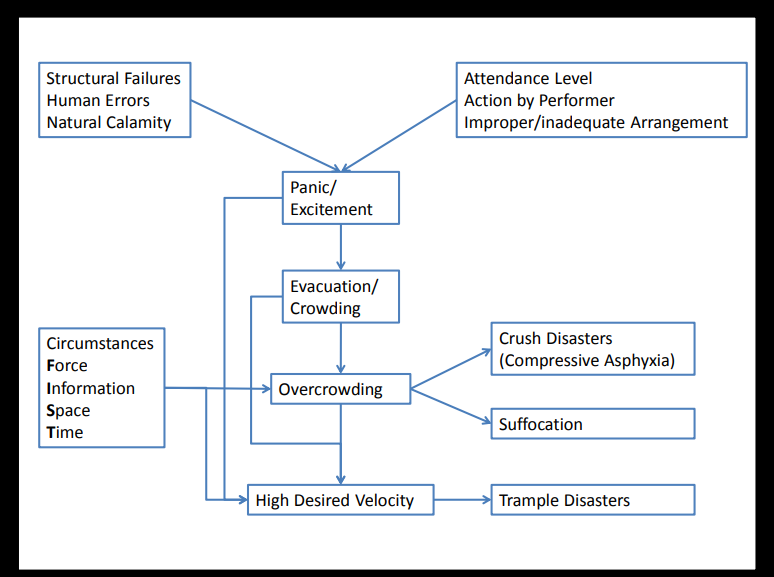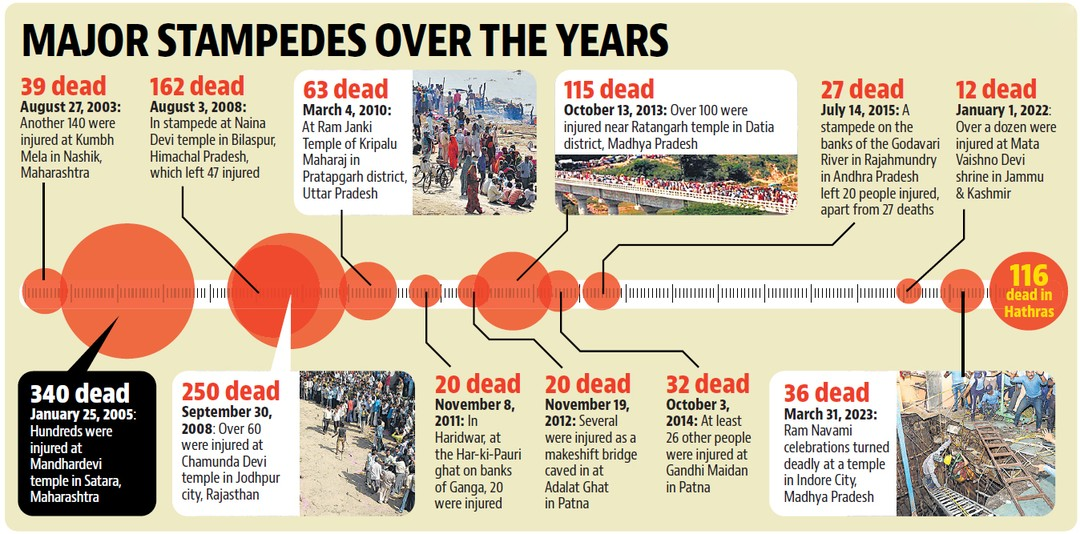Disaster Management and Stampedes | 08 Jul 2024
For Prelims: National Disaster Management Authority, Disaster Management Act, 2005, Radio Frequency Identification (RFID)
For Mains: Disaster Management, Strategy to address Stampede Management challenges.
Why in News?
Recently, India witnessed another tragic stampede that claimed over 100 lives in Uttar Pradesh's Hathras district.
- This devastating incident adds to a long list of similar tragedies that have occurred during religious gatherings and festivals across the country over the past two decades.
- These events highlight the ongoing challenges of managing large crowds in confined spaces and underscore the urgent need for improved safety measures.
What is a Stampede?
- About: A stampede is an impulsive mass movement of a crowd that often results in injuries and deaths. It is often triggered by response to a perceived danger, loss of physical space and a collective will to attain something seen as gratifying.
- Types: Two main types of stampedes are Unidirectional stampedes occur when a crowd moving in the same direction encounters a sudden change in force, triggered by forces like sudden stops or negative forces like broken barriers.
- Turbulent stampedes happen in situations with uncontrolled crowds, induced panic, or crowds merging from multiple directions.
- Fatalities in Stampedes: Stampedes can cause fatalities through:
-
Traumatic Asphyxia: It is the most common cause that occurs due to external compression of the thorax or upper abdomen. Can happen even in moderate crowds of 6-7 people pushing in one direction.
-
Other causes: Myocardial infarction (heart attack), Direct crushing injuries to internal organs, Head injuries and Neck compression.
-
-
Factors Contributing to Stampedes:
- Psychological Factors: Panic is a primary trigger or amplifier of stampedes.
- Loss of cooperative behaviour in emergencies. In panic-producing situations, cooperation is initially beneficial. Once cooperative behaviour is disturbed, individual survival instincts take over and result in stampedes.
- Environmental and Design Elements:
- Lack of proper lighting.
- Poor crowd flow management (Failure to divide crowd flow for different groups).
- Collapse of barriers or buildings.
- Blocked exits or evacuation routes.
- Fire hazards.
- High crowd density, when density approaches 3-4 persons per square metre. At this density, evacuation time increases dramatically, raising panic and stampede risk.
- Psychological Factors: Panic is a primary trigger or amplifier of stampedes.
- Impact of Stampedes:
-
Psychological Trauma: Survivors and witnesses may experience long-term psychological trauma, including Post-traumatic Stress Disorder (PTSD).
-
Economic Consequences: Stampedes primarily affect economically disadvantaged individuals, leaving families without primary earners and causing significant economic hardship in the community.
- Medical expenses, compensation, legal costs, and loss of economic productivity due to injuries.
- Social Impact: Includes loss of trust in event organisers and authorities, social unrest and blame, and negative impact on community morale and cohesion.
-
The aftermath can have far-reaching consequences, requiring efforts to address the underlying issues and prevent similar incidents.
-
-
Impact on Infrastructure: It can cause damage to physical infrastructure, such as barriers and buildings. The costs associated with repairs and upgrades to infrastructure can be significant.
-
What were the Circumstances of Previous Deadly Stampedes in India?
- Mata Vaishno Devi Shrine (2022): 12 killed in a crowd surge during a Hindu pilgrimage in Kashmir.
- Mumbai Pedestrian Bridge (2017): 22 died in a stampede during rush hour.
- Varanasi Bridge (2016): 24 killed crossing a crowded bridge for a religious ceremony.
- Godavari River (2015): 27 dead in a stampede during a Hindu bathing festival.
- Ratangarh Temple (2013): 115 died in a stampede caused by a collapsing bridge.
- Allahabad Train Station (2013): 36 killed due to a platform change during Kumbh Mela.
- Jodhpur Temple (2008): 168 deaths in a stampede during Navratra festival celebrations.
- Naina Devi Temple (2008): 145 killed in a stampede triggered by rumors of a landslide.
- Wai Temple (2005): 258 lives lost in a stampede and subsequent fire.
What are the Initiatives of India to Control Stampedes?
- The National Disaster Management Authority (NDMA) provides guidelines for safe crowd management and precautions during festive seasons.
- Traffic and Crowd Management: NDMA advises regulating traffic, displaying route maps, and using barricades to control pedestrian flow around festive venues.
- Security Measures: Emphasising CCTV surveillance and increased police presence to deter crimes, NDMA urges organisers to manage unauthorised parking and stalls effectively.
- Medical Preparedness: NDMA recommends having ambulances on standby and medical staff ready, with clear signage directing to nearby hospitals.
- Crowd Safety Tips: Educating attendees on exit routes and calm behaviour during gatherings, NDMA stresses preparedness for handling stampede scenarios.
- Fire Safety: NDMA highlights precautions such as safe electrical wiring, monitoring LPG cylinder usage, and caution with fireworks to prevent fires.
- Disaster Risk Reduction: NDMA supports government initiatives and upcoming conferences like the Asian Ministerial Conference in collaboration with United Nations International Strategy for Disaster Reduction (UNISDR), focusing on disaster resilience and recognizing the sendai framework.
- Community Responsibility: NDMA underscores collective responsibility in disaster prevention and promoting safety during festive events.
National Disaster Management Authority (NDMA)
- The NDMA, led by the Prime Minister of India, is the apex statutory body for Disaster Management in the country. It was established as per the Disaster Management Act, 2005 to create institutional mechanisms at the State and District levels.
- NDMA is responsible for setting policies, plans, and guidelines for Disaster Management, with a focus on prevention, mitigation, preparedness, and response.
- It aims to create a safer and disaster-resilient India through a proactive and sustainable development strategy.
What Can be Done Better to Prevent Stampedes?
- Real-time Density Monitoring: Deploy a network of sensors (thermal, LiDAR) to monitor crowd density in real-time. This data can feed into AI models to predict crowd surges and trigger early warnings.
- Introduce Radio Frequency Identification (RFID) tags in tickets or wristbands. This allows for real-time tracking of crowd movement, identifying congested areas, and enabling targeted communication via displays.
- Utilise drones equipped with high-resolution cameras and thermal imaging for real-time crowd surveillance and anomaly detection. These can also project calming messages or announcements on large screens.
- Intelligent Lighting Systems: Implement crowd-responsive lighting that can adjust brightness and colour based on crowd density to guide movement or calm situations.
- Implement pathways and walkways embedded with bioluminescent materials that automatically glow brighter in case of emergencies. This can guide movement and reduce panic in low-light situations.
- Interactive Communication Displays: Install interactive displays that show real-time wait times, evacuation routes, and essential information in multiple languages.
- Campaigns: Launch public awareness campaigns to educate people on crowd safety protocols and proper behaviour during large gatherings.
|
Drishti Mains Question: Q. Analyse the effectiveness of disaster risk reduction initiatives by the Indian government in the context of stampede prevention. What improvements can be made? |
UPSC Civil Services Examination, Previous Year Questions (PYQs)
Mains
Q. Discuss the recent measures initiated in disaster management by the Government of India departing from the earlier reactive approach. (2020)


